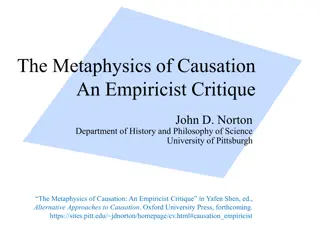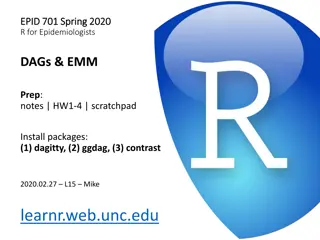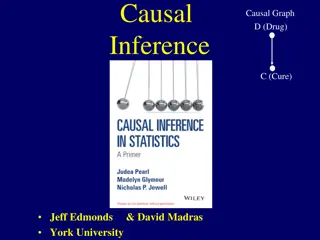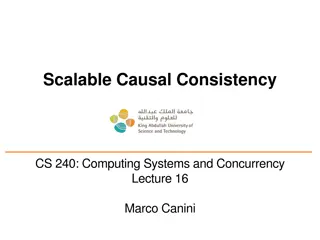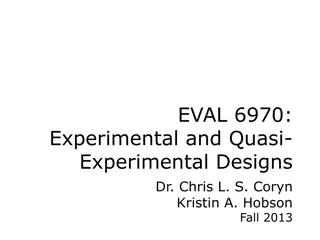Deriving Causal Inference from Nature
Uncover the nuances of causal relationships through experiments focusing on barnacles, substrate types, and potential outcomes. Explore the depth of mechanistic understanding and address confounding factors to refine your experimental design for robust causal inference.
Download Presentation

Please find below an Image/Link to download the presentation.
The content on the website is provided AS IS for your information and personal use only. It may not be sold, licensed, or shared on other websites without obtaining consent from the author.If you encounter any issues during the download, it is possible that the publisher has removed the file from their server.
You are allowed to download the files provided on this website for personal or commercial use, subject to the condition that they are used lawfully. All files are the property of their respective owners.
The content on the website is provided AS IS for your information and personal use only. It may not be sold, licensed, or shared on other websites without obtaining consent from the author.
E N D
Presentation Transcript
Deriving Causal Inference from Nature with Experiments
Build an Understanding of Our System to Design Experiments 1. Using Causal Diagrams with a System to Design a simple Experiment 2. Designs Manipulating One Thing 3. Causal Implications of Experimental Manipulations You Might Not have Thought Of 4. Treatment Assignment 5. Manipulating More than One Thing
Barnacles and Substrate Type Focus POTENTIAL OUTCOMES National Marine Sanctuaries Bigelow.org ?
Example from Gotelli and Ellison: Substrate and Barnacles Substrate Type Barnacles
First: What How Deeply Mechanistic Do You Want to Get? Substrate Roughness Substrate Type Other Properties Barnacles You can follow the mechanistic rabbit hole as deep as you want for your question, but it is not always necessary Substrate Temperature
Barnacles and Rugosity POTENTIAL OUTCOMES ? ? Bigelow.org
In vitro versus In vivo NOAA/AOML Trussel Lab
Our Worry. Other Site Factors Substrate Type Barnacles Fight the Confounding!
Flesh Out the System Other Site Factors Predation Substrate Type Barnacles Source of treatment heterogeneity bias Within-Site Variability Source of selection bias Recruitment Any other assumptions you see here?
Sever Links to Get at Causal Inference Via an Experiment or Statistical Control Other Site Factors x Other Site Factors=0 x Predation Predation = Constant x x Substrate Type Barnacles xx Within-Site Variability Recruitment = Recruitment Constant Your inference will be circumscribed, but you have to start somewhere!
Causal Diagrams and Experimental Design Use your diagram to determine what influences you can cut out Your choices in experimental design can be charted on your diagram You can then tell if your resulting design is causally identified or not
Build a simplified causal diagram of your system. Then diagram out how you would turn it into an experiment that answers your question of interest.
Build an Understanding of Our System to Design Experiments 1. Using Causal Diagrams with a System to Design a simple Experiment 2. Designs Manipulating One Thing 3. Causal Implications of Experimental Manipulations You Might Not have Thought Of 4. Treatment Assignment 5. Manipulating More than One Thing
To Start: Substrate Only One-Way Layout Substrate Type = slate, granite, concrete How many replicates of each treatment? Placement of replicates Randomize or randomize within gradient Scale over which to run experiment Dispersion of treatments to ensure independence Barnacles
A Word on Continuous v. Categorical Designs Substrate Rugosity = 0- 100 Regression-based designs can work like ANOVA-based designs You can assign treatment levels evenly You can assign discrete levels and add random noise The causal model is *THIS SAME*, it s the details of implementation and statistical modeling that are different Barnacles
Our One-Way Design Substrate Type = slate, granite, concrete Slate Granite Concrete Barnacles
How Many Replicates Do I Need? Generally, p^(3/2) / ntot should approach 0 Portnoy 1998 So, 3 means p^(3/2) ~ 5 So, 5 / (3*n) should be close-ish to 0 Practically, 5-10
5-10 Replicates? Thats it? Not so fast! The noisier the system and smaller the effect, the more replicates you need for good precision
OK, How do I Determine Power (or Likely Precision) SIMULATION! Make a simulated data set with your design, fit a model, get SE of parameters or other indices Rinse and repeat to see how often you fall in an acceptable range
Build an Understanding of Our System to Design Experiments 1. Using Causal Diagrams with a System to Design a simple Experiment 2. Designs Manipulating One Thing 3. Causal Implications of Experimental Manipulations You Might Not have Thought Of 4. Treatment Assignment 5. Manipulating More than One Thing
Reality Check: Lots of Things Happen in an Experiment they are Not So Simple!
Internal Validity versus External Validity Other Site Factors x x Predation = none, ambient x x x Barnacles Recruitment Results are valid for one site where experiment was conducted High Internal Validity Substrate Type = slate, granite, concrete What do they teach us about predation and substrate in nature? If no recruitment interaction, High External Validity Otherwise, Low External Validity
Decisions as to How to Treat Moderators & Validity Averaging Over versus Holding Constant If we wanted to know the direct causal effect of substrate type, should we hold predation pressure constant, or do the experiment at many levels of predation? Predation Barnacles Substrate Type
Are You Introducing Hidden Treatments? Predation = Caged, Uncaged Barnacles
Are You Introducing Hidden Treatments? Predator Access Cage Treatment = Caged, Uncaged Barnacles Flow of Water Violation of excludability - outcomes responding solely to treatment through desired pathway Kimmel et al. 2021
Solution Diagram it to Devise Procedural Controls Predator Access Cage Treatment = Caged, Uncaged, Sides Barnacles Flow of Water
Solution Diagram it to Devise Procedural Controls with Separate Exogenous Variables Open Predator Access Caged Barnacles Sides Flow of Water
Causal Diagrams of an Experiment Re-diagram your system as an experiment Think carefully about what is added and what is subtracted What is the scope of your inference when you compare your diagram of an experiment to that of the world? Did you open any new back doors? How can you close them?
Evaluate your experimental diagram would you change anything? Why?
Build an Understanding of Our System to Design Experiments 1. Using Causal Diagrams with a System to Design a simple Experiment 2. Designs Manipulating One Thing 3. Causal Implications of Experimental Manipulations You Might Not have Thought Of 4. Treatment Assignment 5. Manipulating More than One Thing
Replicate Placement In An Area of Minimal Variation in Other Conditions Randomize coordinates Or petri dish placement, labbies! Once you accommodate, gradients, etc., it s a different design Note this is done at one *time* as well
Bad Replicate Placement: Non-Independence of Plots If there is bleedover from one plot to the next, you violate the principle of interference Plots must be spatially or temporally separate Heats This goes double for plots with the same treatment! Kimmel et al. 2021
Bad Replicate Placement: Non-Independence of Treatments Pseudoreplication sensu Hurlbert Really a violation of excludability sensu Kimmel et al., as treatment = treatment + location
Is it Pseudoreplication How Many Replicates Are There? If treatments AND plots are non- independent, this is a problem with n = 2, not 4
Subsampling (Nested Design) Can be Great! If you take subsamples from true replicates, can minimize within replicate variation ...... ... ... ... ... ... ... ... ... Average subsamples ... ... Or use mixed models
Repeated Measures as Subsamples Let s say these were samples through time Analyze the same way UNLESS there is change through time Then, need to consider plot AND a time effect
What if There is a Gradient? Tide Height
Two-Way Blocked Design: Additivity with n = 1 per block/treatment Substrate Type Block What model would you use? Barnacles
Randomized Controlled Blocked Design (RCBD) Randomize treatment placement within blocks Accommodates potential other gradients nblock = ntrt replicates
What Can Blocks Be? Areas along a gradient Plots close together in patches Replicates run at the same time And more!
Many Gradients? Latin Squares! Columns Substrate Type Rows Column Row Barnacles
Build an Understanding of Our System to Design Experiments 1. Using Causal Diagrams with a System to Design a simple Experiment 2. Designs Manipulating One Thing 3. Causal Implications of Experimental Manipulations You Might Not have Thought Of 4. Treatment Assignment 5. Manipulating More than One Thing
Two Way Designs are Not Just for Blocks Predation = Caged, Uncaged, Cage Control Barnacles Substrate Type = slate, granite, concrete But assumes additivity
Beyond Additivity: Factorial Designs Treatment A, Level 1 Treatment A, Level 2 Treatment B, Level 1 N=5 N=5 Treatment B, Level 2 N=5 N=5
Factorial Blocked Design: Does your Treatment Vary by Block? Substrate Type Block Block 1 Block 2 Block 3 What model would you use? Barnacles Useful for site variation, temporal variation, and more
Factorial Designs are Not Just for Blocks Predation = Caged, Uncaged, Cage Control Predation* Substrate Barnacles Substrate Type = slate, granite, concrete
You can Mix Things e.g., Blocks and Factorial Design (re-randomize each block) Block 1 Block 2 Block 3



